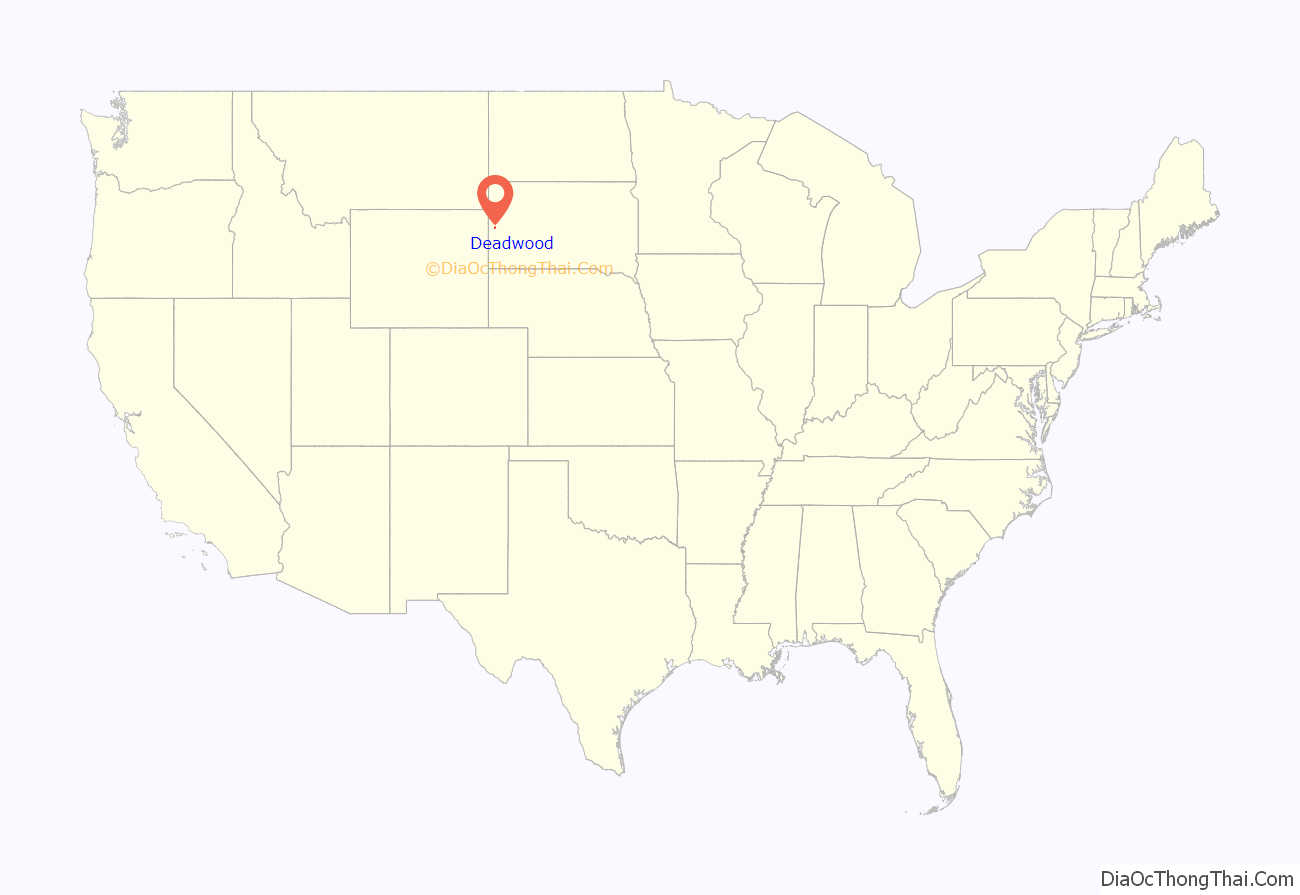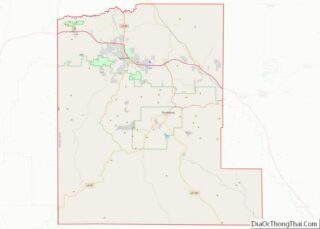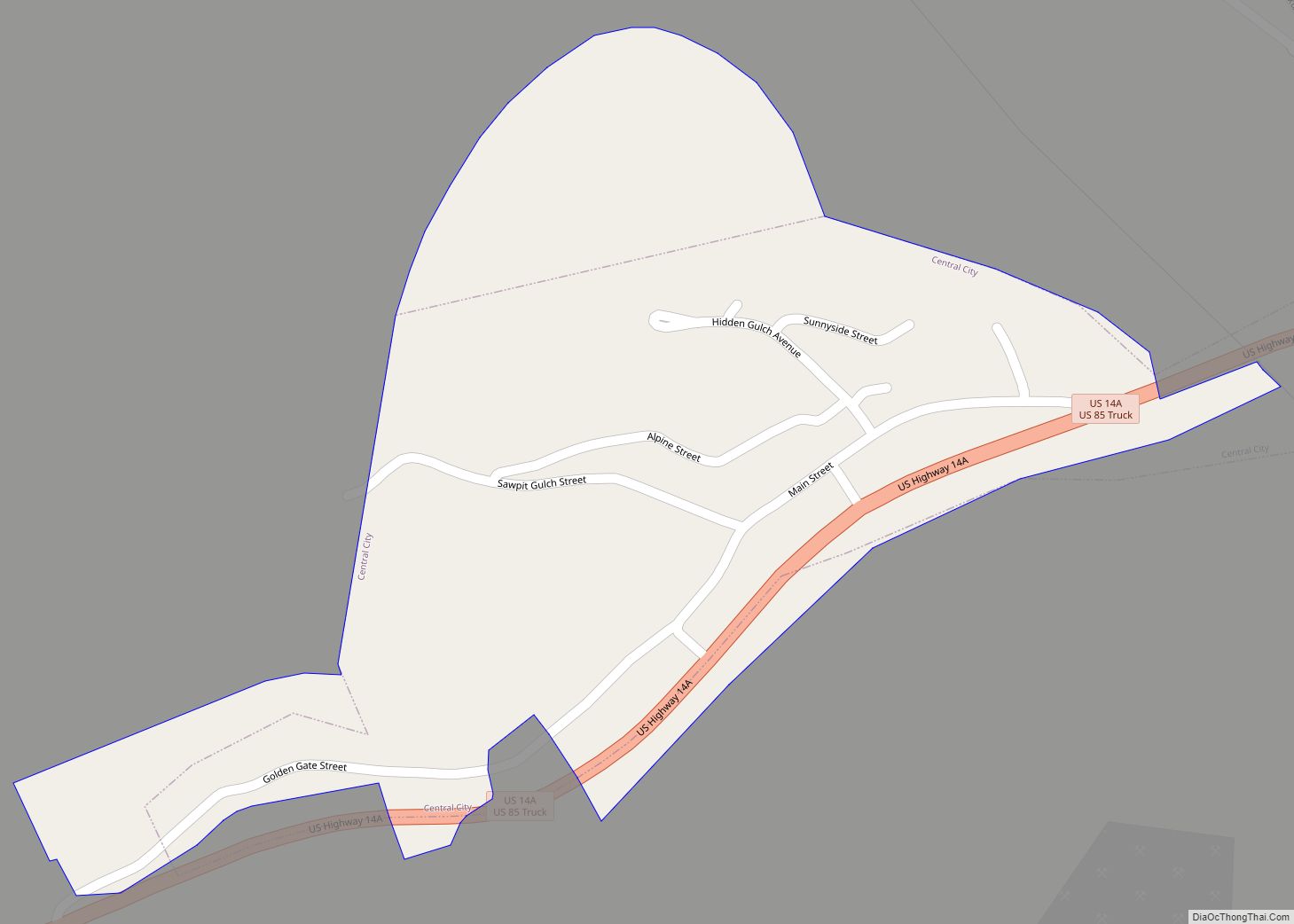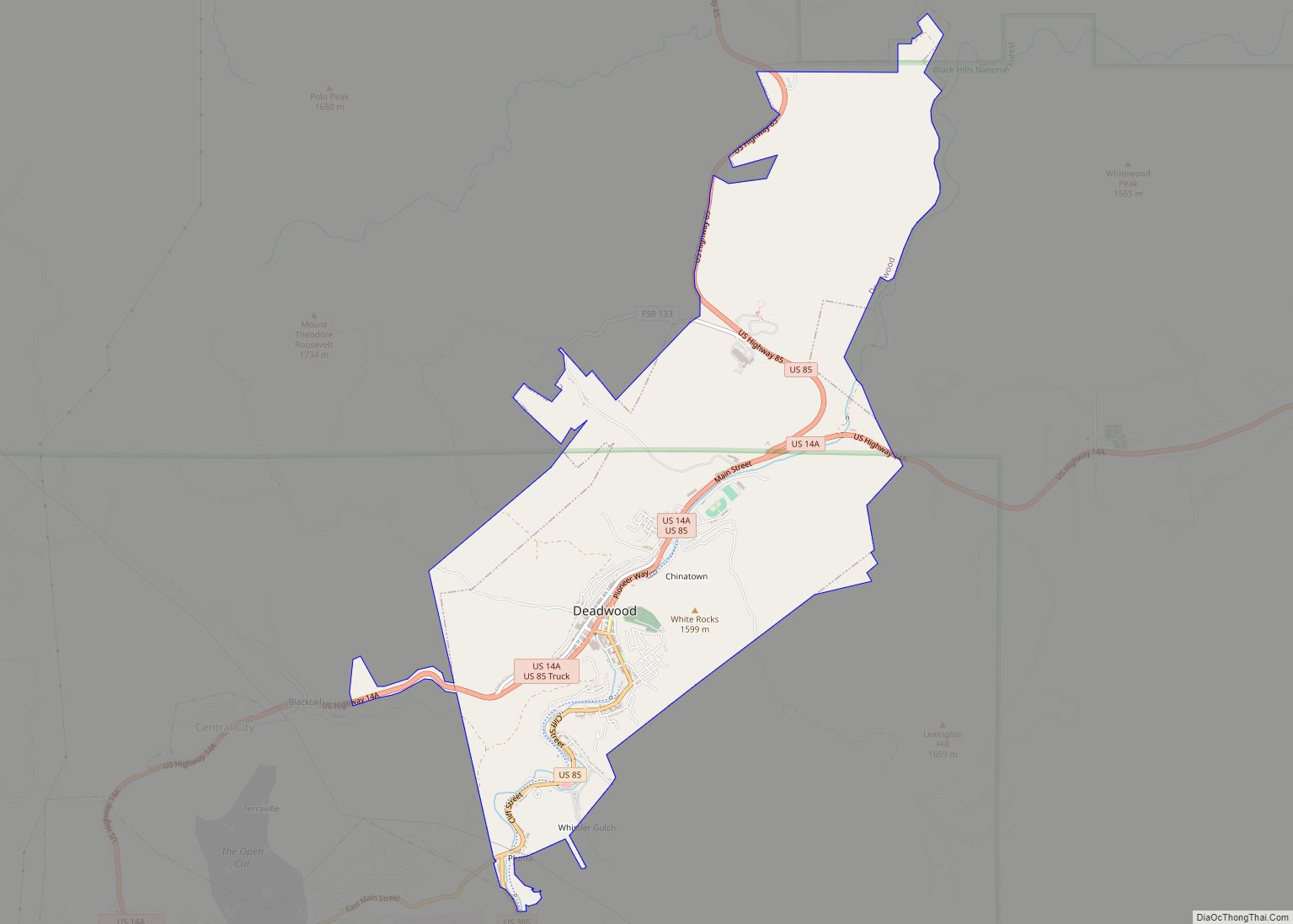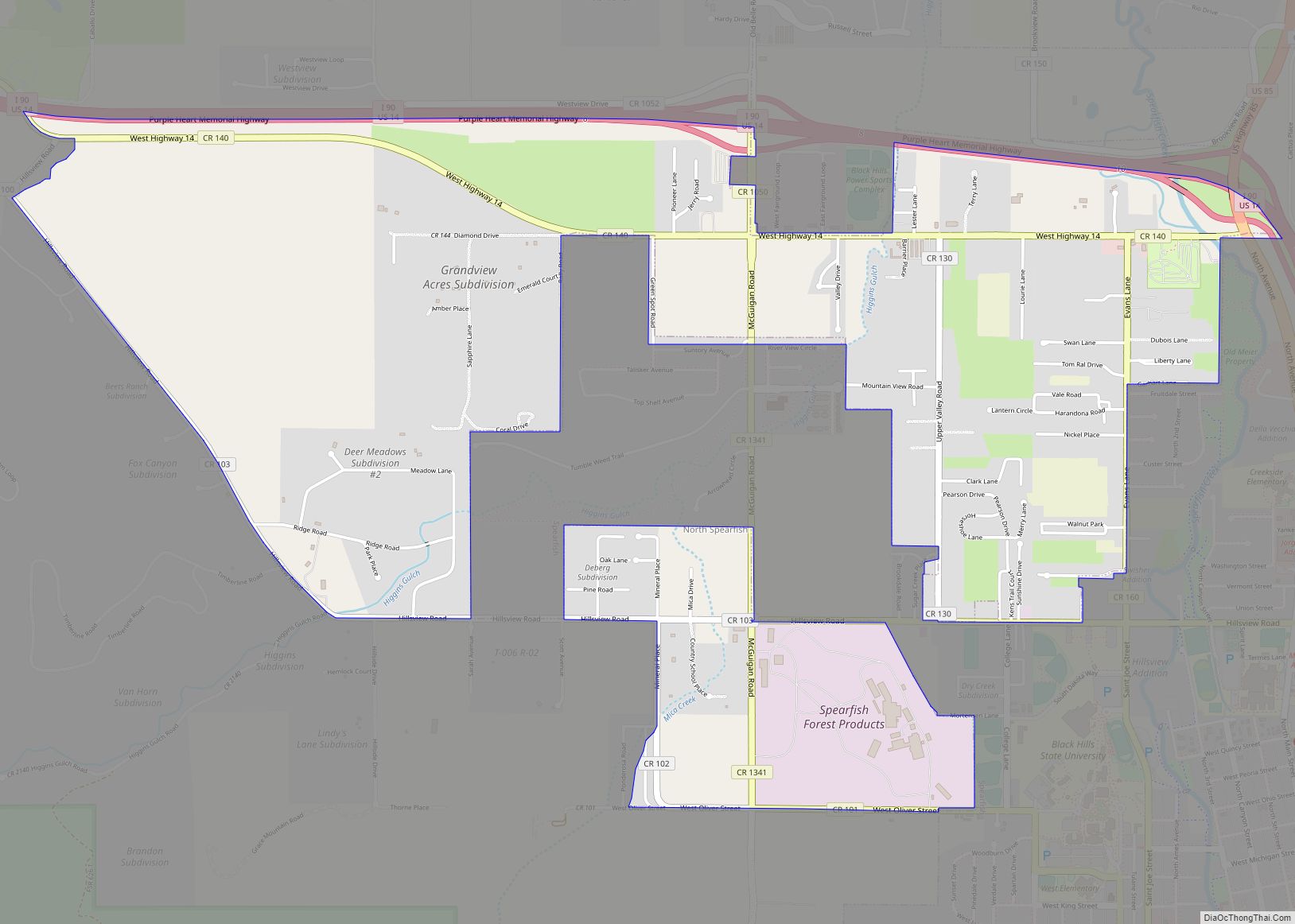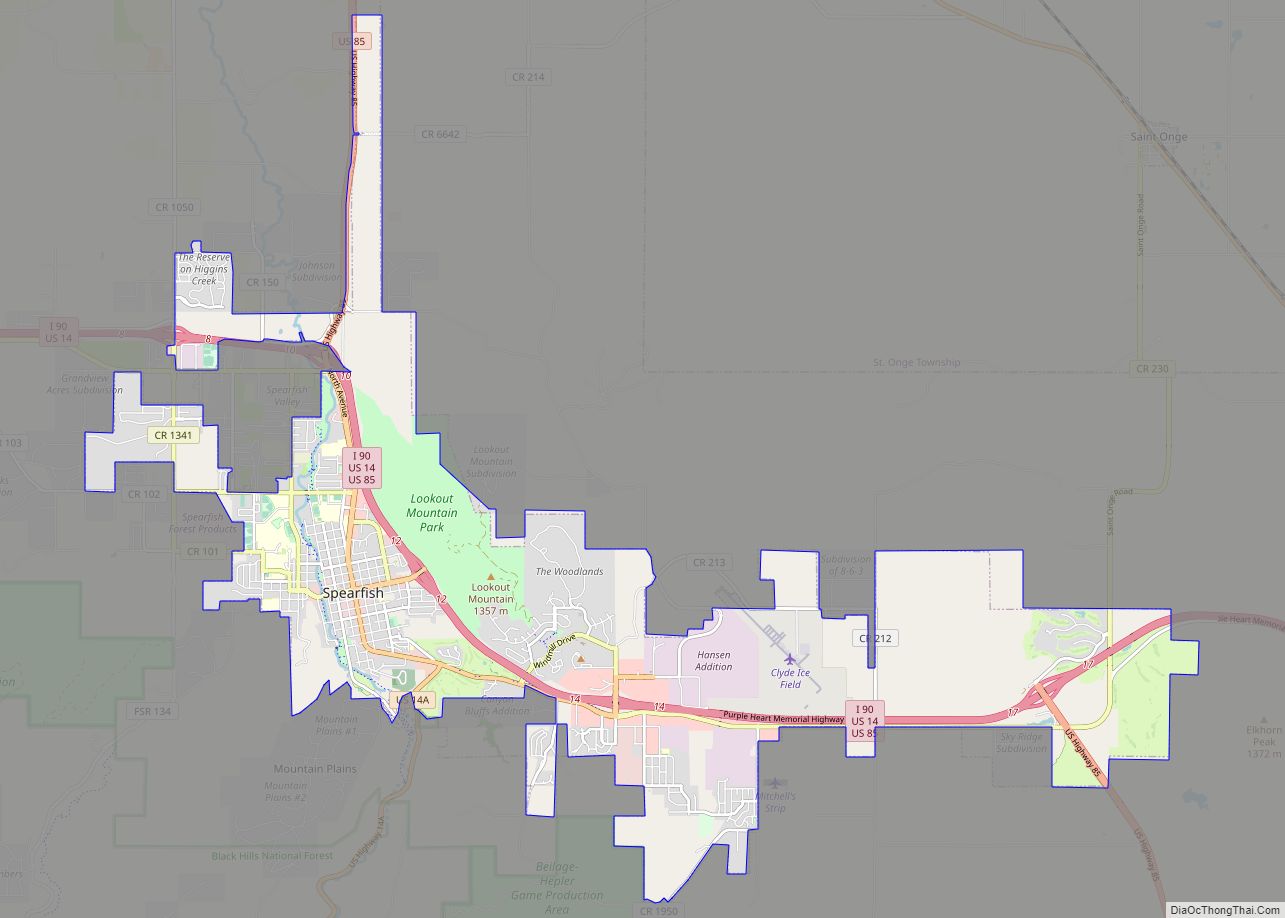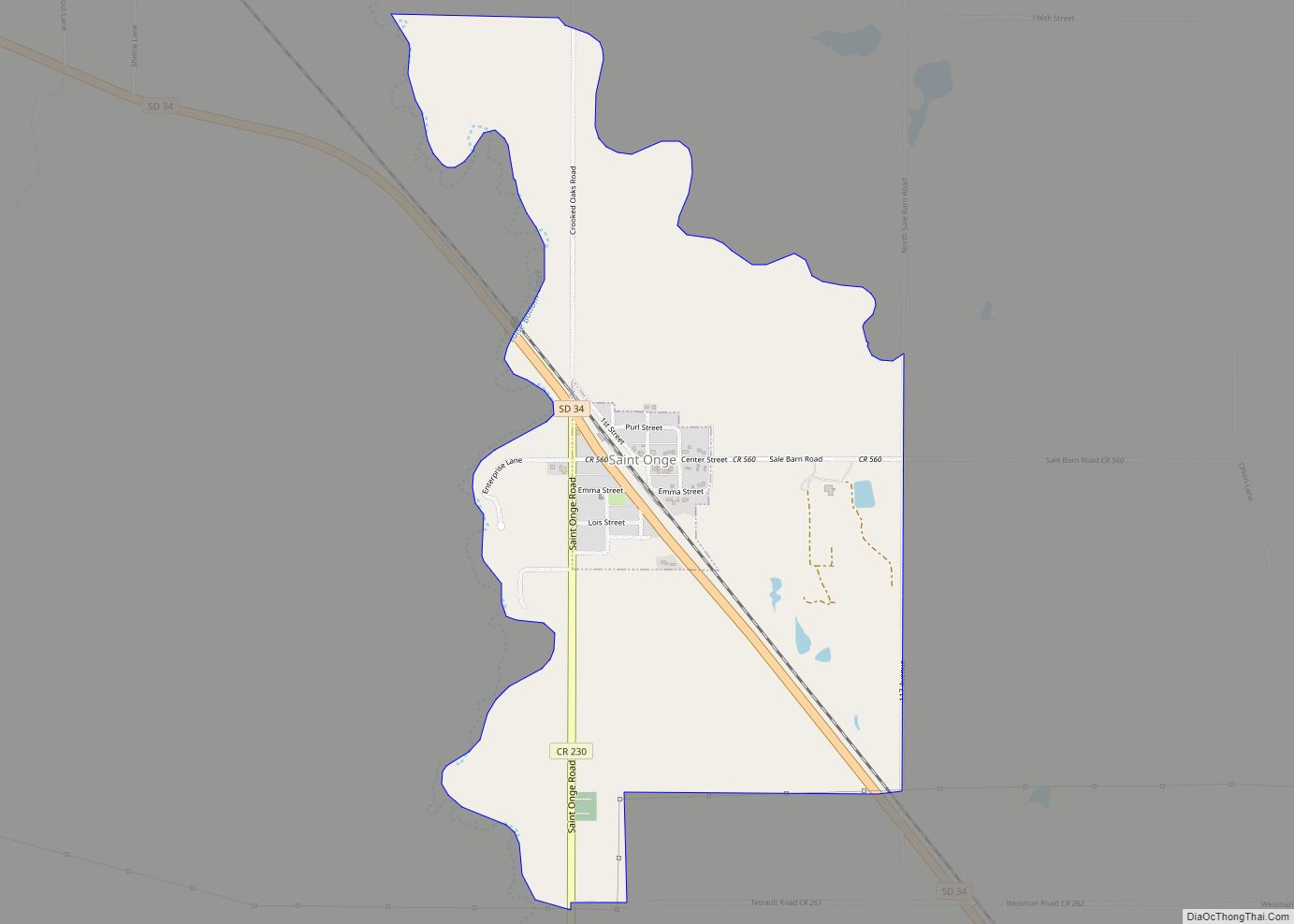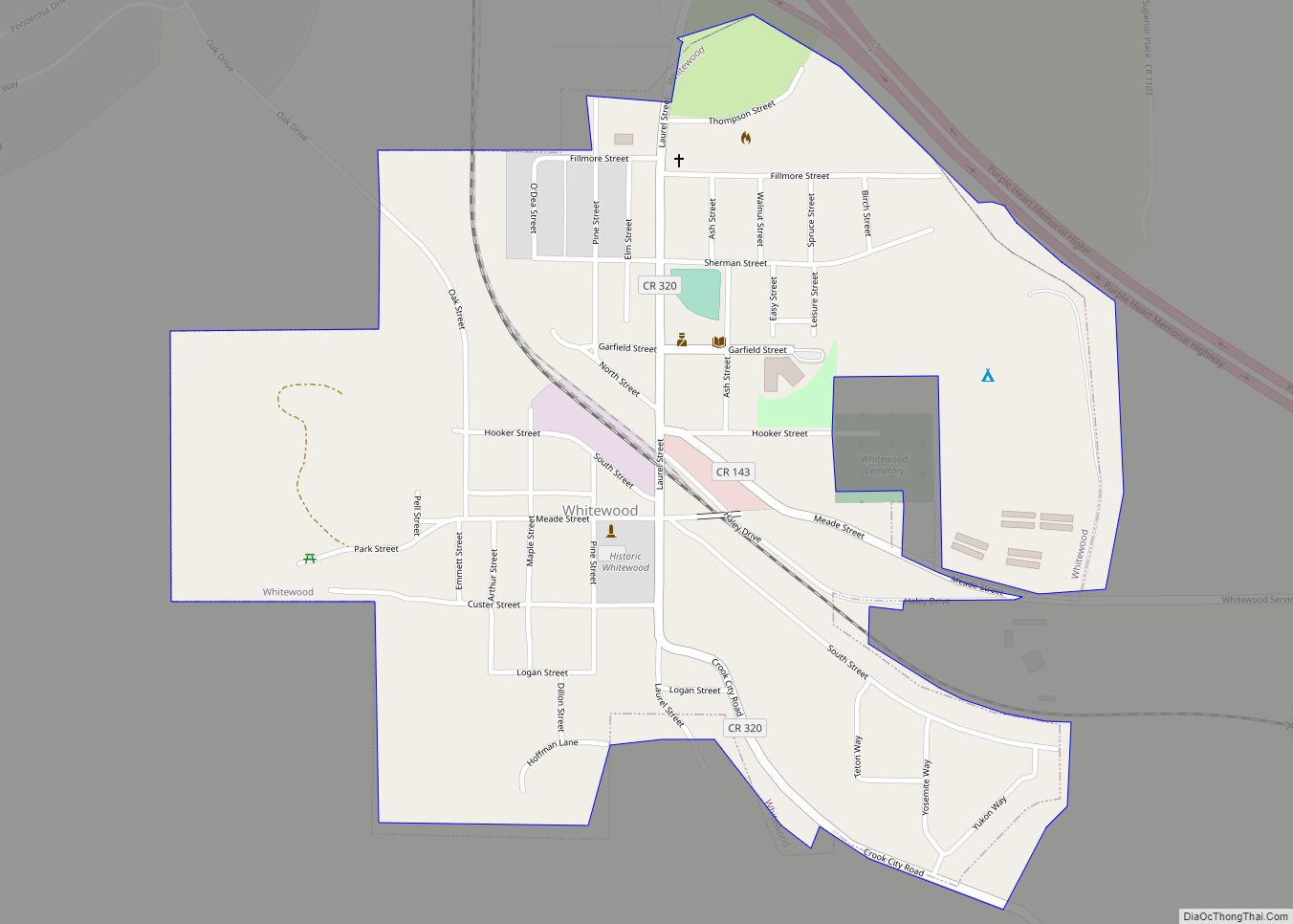Deadwood (Lakota: Owáyasuta; “To approve or confirm things”) is a city that serves as county seat of Lawrence County, South Dakota, United States. It was named by early settlers after the dead trees found in its gulch. The city had its heyday from 1876 to 1879, after gold deposits had been discovered there, leading to the Black Hills Gold Rush. At its height, the city had a population of 25,000, attracting Old West figures such as Wyatt Earp, Calamity Jane, and Wild Bill Hickok (who was killed there).
The population was 1,156 at the 2020 census. The entire town has been designated as a National Historic Landmark District, for its well-preserved Gold Rush-era architecture. Deadwood’s proximity to Lead often prompts the two towns being collectively named “Lead-Deadwood”.
| Name: | Deadwood city |
|---|---|
| LSAD Code: | 25 |
| LSAD Description: | city (suffix) |
| State: | South Dakota |
| County: | Lawrence County |
| Founded: | 1876 |
| Elevation: | 4,531 ft (1,381 m) |
| Total Area: | 4.93 sq mi (12.77 km²) |
| Land Area: | 4.93 sq mi (12.77 km²) |
| Water Area: | 0.00 sq mi (0.00 km²) |
| Total Population: | 1,156 |
| Population Density: | 234.53/sq mi (90.55/km²) |
| ZIP code: | 57732 |
| Area code: | 605 |
| FIPS code: | 4615700 |
| GNISfeature ID: | 1265180 |
| Website: | www.cityofdeadwood.com |
Online Interactive Map
Click on ![]() to view map in "full screen" mode.
to view map in "full screen" mode.
Deadwood location map. Where is Deadwood city?
History
19th century
The settlement of Deadwood began illegally in the 1870s, on land which had been granted to the Lakota people in the 1868 Treaty of Fort Laramie. The treaty had guaranteed ownership of the Black Hills to the Lakota people, who considered this area to be sacred. The settlers’ squatting led to numerous land disputes, several of which reached the United States Supreme Court.
Everything changed after Colonel George Armstrong Custer led an expedition into the Black Hills and announced the discovery of gold in 1874, on French Creek near present-day Custer, South Dakota. This announcement was a catalyst for the Black Hills Gold Rush, and miners and entrepreneurs swept into the area. They created the new and lawless town of Deadwood, which quickly reached a population of approximately 5,000. By 1877, about 12,000 people settled in Deadwood, while other sources put the peak number even at 25,000 in 1876.
In early 1876, frontiersman Charlie Utter and his brother Steve led to Deadwood a wagon train containing what they believed were needed commodities, to bolster business. The town’s numerous gamblers and prostitutes staffed several profitable ventures. Madame Mustache and Dirty Em were on the wagon train, and set up shop in what was referred to as Deadwood Gulch. Women were in high demand by the miners, and the business of prostitution proved to have a good market. Madam Dora DuFran eventually became the most profitable brothel owner in Deadwood, closely followed by Madam Mollie Johnson.
Deadwood became known for its lawlessness; murders were common, and justice for murders not always fair and impartial. The town attained further notoriety when gunman Wild Bill Hickok was killed on August 2, 1876. Both he and Calamity Jane were buried at Mount Moriah Cemetery, as well as other notable figures such as Seth Bullock.
Hickok’s murderer, Jack McCall, was prosecuted twice, despite the U.S. Constitution’s prohibition against double jeopardy. Because Deadwood was an illegal town in Indian Territory, non-native civil authorities lacked the jurisdiction to prosecute McCall. McCall’s trial was moved to a Dakota Territory court, where he was found guilty of murder and hanged.
Beginning August 12, 1876, a smallpox epidemic swept through. So many people fell ill that tents were erected to quarantine the stricken.
In 1876, General George Crook pursued the Sioux Indians from the Battle of Little Big Horn, on an expedition that ended in Deadwood in early September, known as the Horsemeat March. The same month, businessman Tom Miller opened the Bella Union Saloon.
On April 7, 1877, Al Swearengen, who controlled Deadwood’s opium trade, also opened a saloon; his was called the Gem Variety Theater. The saloon burned down and was rebuilt in 1879. When it burned down again in 1899, Swearengen left town.
As the economy changed from gold panning to deep mining, the individual miners went elsewhere or began to work in other fields. Hence Deadwood lost some of its rough and rowdy character, and began to develop into a prosperous town.
The Homestake Mine in nearby Lead was established in October 1877. It operated for more than a century, becoming the longest continuously operating gold mine in the United States. Gold mining operations did not cease until 2002. The mine has been open for visiting by tourists.
On September 26, 1879, a fire devastated Deadwood, destroying more than 300 buildings and consuming the belongings of many inhabitants. Many of the newly impoverished left town to start again elsewhere.
In 1879, Thomas Edison demonstrated the first successful incandescent lamp in New Jersey, and on September 17, 1883, Judge Squire P. Romans took a gamble and founded the “Pilcher Electric Light Company of Deadwood”. He ordered an Edison dynamo, wiring, and 15 incandescent lights with globes. After delays, the equipment arrived without the globes. Romans had been advertising an event to show off the new lights and decided to continue with the lighting, which was a success. His company grew. Deadwood had electricity service fewer than four years after Edison commercialized it, less than a year after commercial service was started in Roselle, New Jersey, and around the same time that many larger cities around the country established the service.
In 1888, J.K.P. Miller and his associates founded a narrow-gauge railroad, the Deadwood Central Railroad, to serve their mining interests. In 1893, Chicago, Burlington and Quincy Railroad purchased the railroad. In 1902, a portion of the railroad between Deadwood and Lead was electrified for operation as an interurban passenger system, which operated until 1924. In 1930, the railroad was abandoned, apart from a portion from Kirk to Fantail Junction, which was converted to standard gauge. In 1984, Burlington Northern Railroad abandoned the remaining section.
Some of the other early town residents and frequent visitors included Martha Bullock, Aaron Dunn, E. B. Farnum, Samuel Fields, A. W. Merrick, Dr. Valentine McGillycuddy, Reverend Henry Weston Smith, Sol Star, and Charlie and Steve Utter.
Chinatown
The gold rush attracted Chinese immigrants to the area; their population peaked at 250. A few engaged in mining; most worked in service enterprises. A Chinese quarter arose on Main Street, as there were no restrictions on foreign property ownership in Dakota Territory, and a relatively high level of tolerance of different peoples existed in the frontier town. Wong Fee Lee arrived in Deadwood in 1876 and became a leading merchant. He was a community leader among the Chinese Americans until his death in 1921.
The quarter’s residents also included African Americans and European Americans. During the 2000s, the state sponsored an archeological dig in the area, to study the history of this community of diverse residents.
20th and 21st centuries
Another major fire in September 1959 nearly destroyed the town again. About 4,500 acres (1,800 ha) were burned and an evacuation order was issued. Nearly 3,600 volunteer and professional firefighters, including personnel from the Homestake Mine, Ellsworth Air Force Base, and the South Dakota National Guard’s 109th Engineer Battalion, worked to contain the fire. The property losses resulted in a major regional economic downturn.
In 1961, the entire town was designated a National Historic Landmark, for its well-preserved collection of late 19th-century frontier architecture. Most of the town’s buildings were built before 1900, with only modest subsequent development. The town’s population continued to decline through the 1960s and 1970s. Interstate 90 bypassed Deadwood in 1964, diverting travelers and businesses. On May 21, 1980, a raid by county, state, and federal agents on the town’s three remaining brothels—”The White Door”, “Pam’s Purple Door” and “Dixie’s Green Door”—accomplished, as one reporter put it, “what Marshal Hickok never would have done”, and the houses of prostitution were padlocked. A fire in December 1987 destroyed the historic Syndicate Building and a neighboring structure.
The fire prompted renewed interest in the area and hopes for redevelopment. Organizers planned the “Deadwood Experiment,” in which gambling was tested as a means to stimulate growth in the city center. At the time, gambling was legal only in the state of Nevada and in Atlantic City.
Deadwood was the first small community in the U.S. to seek legal gambling revenue to maintain local historic assets. The state legislature legalized gambling in Deadwood in 1989, which generated significant new revenue and development. The pressure of development since then may have an effect on the historical integrity of the landmark district. Heritage tourism is important for Deadwood and the state.
Deadwood Road Map
Deadwood city Satellite Map
Geography
Deadwood is located at 44°22′36″N 103°43′45″W / 44.37667°N 103.72917°W / 44.37667; -103.72917.
According to the United States Census Bureau, the city has a total area of 3.83 square miles (9.92 km), all land.
Deadwood has been assigned the ZIP code 57732 and the FIPS place code 15700.
Recreation
In the summer, there are numerous trails for hiking, horseback riding, and mountain biking. The northern end of the George S. Mickelson Trail starts in Deadwood and runs south through the Black Hills to Edgemont. Several man made lakes, including Sheridan Lake, provide fishing and swimming. Spearfish Canyon to the north has many places to rock climb. In early June, the Mickelson Trail Marathon and 5K, as well as accompanying races for children, are held.
During the winter, two ski areas operate just a few miles outside of nearby Lead, South Dakota: Terry Peak and Deer Mountain.
The Midnight Star was a casino in Deadwood owned by American film actor Kevin Costner. The casino opened in the spring of 1991, after Costner had directed and starred in the Academy Award-winning film Dances With Wolves (1990), which was filmed mainly in South Dakota. The Midnight Star was a saloon which featured prominently in the previous western Costner had acted in, Silverado (1985), one of his first major roles. International versions of many of his films’ posters lined the walls. The casino closed in August 2017.
Climate
Deadwood’s climate varies considerably from the rest of the state and surrounding areas. While most of the state receives less than 25 inches (640 mm) of precipitation per year, annual precipitation in the Lead—Deadwood area reaches nearly 30 inches (760 mm). Despite a mean annual snowfall of 102.9 inches (2.6 m), warm chinook winds are frequent enough that the median snow cover is zero even in January, although during cold spells after big snowstorms there can be considerable snow on the ground. On November 6, 2008, after a storm had deposited 45.7 inches (1.2 m) of snow, with a water equivalent of 4.25 inches (108 mm), 35 inches (0.9 m) of snow lay on the ground.
Spring is brief, and is characterized by large wet snow storms and periods of rain. April 2006, although around 4 °F (2.2 °C) hotter than the long-term mean overall, saw a major storm of 54.4 inches (1.4 m), with a water equivalent 4.3 inches (109 mm), and left a record snow depth of 39 inches (1 m) on the 19th. Typically the first 70 °F (21 °C) temperature will be reached at the beginning of April, the first 80 °F (27 °C) near the beginning of May, and the first 90 °F (32 °C) around mid-June. Despite the fact that warm afternoons begin occasionally so early, 191.1 mornings each year fall to or below freezing, and even in May 6.8 mornings reach this temperature. Over the year, 0 °F or −17.8 °C is reached on 17.8 mornings per year, and 47.9 afternoons do not top freezing. The spring season sees heavy snow and rainfall, with 34 inches (0.9 m) of snow having fallen in April 1986 and as much as 15.99 inches (406 mm) of precipitation in the record wet May 1982.
The summer season is very warm, although with cool nights: only one afternoon in five years will top 100 °F (38 °C), and only 10.7 afternoons equal or exceed 90 °F (32 °C). Rainfall tapers off during the summer: August 2000 was one of only two months in the 30-year 1971 to 2000 period to see not even a trace of precipitation. The fall is usually sunny and dry, with increasingly variable temperatures. The last afternoon of over 80 °F (27 °C) can be expected on October 5, but the first morning freeze can be expected as early as September 23, and the first snowfall also around October 5.
Since records began in 1948, the hottest temperature has been 103 °F (39.4 °C) most recently on July 10, 1954, and the coldest −30 °F (−34.4 °C) during the great freeze of December 1989.
See also
Map of South Dakota State and its subdivision:- Aurora
- Beadle
- Bennett
- Bon Homme
- Brookings
- Brown
- Brule
- Buffalo
- Butte
- Campbell
- Charles Mix
- Clark
- Clay
- Codington
- Corson
- Custer
- Davison
- Day
- Deuel
- Dewey
- Douglas
- Edmunds
- Fall River
- Faulk
- Grant
- Gregory
- Haakon
- Hamlin
- Hand
- Hanson
- Harding
- Hughes
- Hutchinson
- Hyde
- Jackson
- Jerauld
- Jones
- Kingsbury
- Lake
- Lawrence
- Lincoln
- Lyman
- Marshall
- McCook
- McPherson
- Meade
- Mellette
- Miner
- Minnehaha
- Moody
- Pennington
- Perkins
- Potter
- Roberts
- Sanborn
- Shannon
- Spink
- Stanley
- Sully
- Todd
- Tripp
- Turner
- Union
- Walworth
- Yankton
- Ziebach
- Alabama
- Alaska
- Arizona
- Arkansas
- California
- Colorado
- Connecticut
- Delaware
- District of Columbia
- Florida
- Georgia
- Hawaii
- Idaho
- Illinois
- Indiana
- Iowa
- Kansas
- Kentucky
- Louisiana
- Maine
- Maryland
- Massachusetts
- Michigan
- Minnesota
- Mississippi
- Missouri
- Montana
- Nebraska
- Nevada
- New Hampshire
- New Jersey
- New Mexico
- New York
- North Carolina
- North Dakota
- Ohio
- Oklahoma
- Oregon
- Pennsylvania
- Rhode Island
- South Carolina
- South Dakota
- Tennessee
- Texas
- Utah
- Vermont
- Virginia
- Washington
- West Virginia
- Wisconsin
- Wyoming
